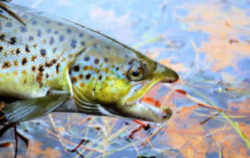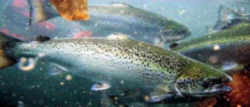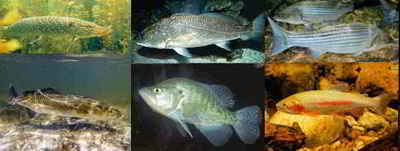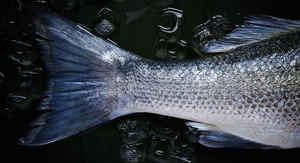Maine State Fish
Landlocked Salmon

(Salmo salar Sebago)
Adopted in 1969.
The Landlocked Salmon, (Salmo salar Sebago,) was designated the official state fish of Maine in 1969.
A subspecies of the Atlantic salmon, live in the lakes of the northern United States without ever descending to sea. Landlocked salmon attain a maximum weight of about 35 lbs. The two most important landlocked populations of the Atlantic salmon are the Sebago salmon, commonly found in New Hampshire, Maine, and New Brunswick, and the ouananiche, of Lac Saint-Jean, Canada.
Maine State Fish: Landlocked Salmon

In the US. landlocks were originally found in just four Maine lake systems- Sebago, Green, Sebec, and Grand. Although many people believe that landlocks are "glaciomarine relicts,"trapped by rising land and dropping sea levels some 10,000 years ago, more recent evidence suggests that certain Atlantic salmon simply stopped going to the ocean. This view is supported by the fact that all four original lakes offered access to the ocean before they were dammed. Scientists do admit that they have no explanation for why some fish would decide to become "voluntarily landlocked."
Native landlock populations are also found in Canada and Scandinavia, and they've been stocked all over the world- not surprising since "salar"is Latin for "leaper,"and one of the distinguishing characteristics of the landlocked salmon is its tendency to go airborne as soon as it feels a hook. More than 175 lakes and 44 rivers in Maine are listed as prime "landlock"fisheries, and you can even find them in the mountains of Argentina.
Characteristics of Landlocked Salmon
From a taxonomic perspective, there is actually no major difference between Atlantics and landlocks, which are sometimes called "landlocked Atlantic salmon."They are the same species, although there are some genetic differences. (The species name for Atlantic salmon is (Salmo salar,) whereas landlocked salmon is (Salmo salar sebago.) The relationship of the two is similar to that of rainbow trout and steelhead (both Oncorhynchus mykiss), in which life history and behavior, rather than genetics, distinguish the two.
Landlocks don't grow as large as their sea-run cousins, generally running between 12 and 20 inches, although much larger specimens can be found in big lakes. The IGFA all-tackle world record, from a lake in Sweden, is 23 pounds 11 ounces, and the largest landlock taken with a fly rod, in Labrador, weighed in at 7-1/2 pounds.
Landlocked salmon never migrate to the sea, living their entire lives in the freshwater lakes of the northern United States and Canada (Maine has 6,000 lakes and ponds). Atlantic salmon are born in freshwater rivers and spend their first 1 to 5 years their before migrating to the ocean where they grow rapidly for 1 to 4 years before returning to their birth-stream to spawn.
- Adult Size: Average size is 16-18 inches and 1-1 1/2 pounds, but 3-5 pound fish are not uncommon.
- Adults are generally silvery with a slightly forked tail and small X-shaped markings on the back and upper sides. Juvenile salmon have a dark red spot between each pair of parr marks. Mature males develop a "kype", or hooked jaw, during the spawning season.
Habitat
- Landlocked salmon are a freshwater form of the sea-run Atlantic salmon.
- Prior to 1868, landlocked salmon populations occurred in only four river basins in Maine: the St. Croix, including West Grand Lake in Washington County; the Union, including Green Lake in Hancock County; the Penobscot, including Sebec Lake in Piscataquis County; and the Presumpscot, including Sebago Lake in Cumberland County.
- Cathance Lake in Washington County was probably the first Maine lake to be artificially stocked with landlocked salmon. This occurred in 1868, using salmon eggs obtained at Grand Lake Stream the previous year.
- Today, landlocked salmon provide the primary fishery in 176 lakes comprising nearly 500,000 acres. They are present and provide incidental fisheries in an additional 127 waters comprising about 160,000 acres. Maine supports one of the largest sport fisheries for this species in the world.
- Landlocked salmon also provide good fisheries in 44 rivers and streams totaling about 290 miles.
Reproduction
- Hatchery stockings are needed to maintain fisheries in 127 lakes (72% of all lakes supporting primary fisheries). These lakes do not have sufficient amounts of suitable spawning and nursery areas to produce wild salmon. Without regular stockings, salmon in these lakes would disappear entirely, or their numbers would be very, very low.
- About 123,000 salmon were stocked annually in Maine lakes from 1996 to 2000.
- Natural reproduction supports salmon fisheries in 49 lakes. These are lakes that have sufficient spawning and nursery habitat to produce enough salmon to support good fisheries. Most of these waters are located in western and northern Maine.
- Salmon spawn in lake outlets or inlets during the period from mid-October to late November. Eggs are buried in gravel from 4-12 inches deep and remain there until hatching early the following spring.
- Young salmon spend from 1 to 4 years in a stream environment prior to migrating to a lake. Recent studies in Maine show most wild salmon (about 75%) spend 2 years as stream dwellers.
- In wild salmon populations, most males spawn first at ages 3 and 4, although a few spawn at ages 1 and 2. Females usually spawn first at ages 4 and 5.
- Spawning runs of wild salmon may be composed of fish ranging in age from 1 to 10, but 3, 4, and 5-year old individuals make up the bulk of most runs.
- Landlocked salmon may be repeat spawners, but most fish observed on spawning runs are spawning for the first time. Salmon may spawn in consecutive or alternate years, some may spawn in consecutive years then skip a year, and some may skip 2 or 3 years between spawnings.
- Salmon populations sustained by natural reproduction often have more older-age fish than those supported by stocking; wild salmon usually exhibit slower growth than do hatchery salmon, so they reach legal size and are harvested 1 or 2 years later.
- The oldest landlocked salmon on record in Maine was 13 years old.
- Rainbow smelts are the principal forage species for salmon in Maine lakes. Without adequate numbers of smelts, salmon growth and body condition will be poor, markedly reducing their value as a sportfish. Maintaining adequate numbers of smelts for forage is the most important element of salmon management in Maine.
- Extensive studies conducted in Maine clearly show that salmon growth rates, and consequently the size of fish available to anglers, is best in lakes with excellent water quality that do not have large populations of other smelt predators, particularly lake trout.
- From 1996 to 2000, Maine open-water anglers voluntarily released over 60% of their catch of legal salmon; ice anglers released about 25% of their legal salmon catch.
- "Catch and release" of salmon has improved fishing in many lakes, but in others it has resulted in depressed smelt populations and smaller salmon, because there are too many salmon. Maine fishery biologists have responded by reducing stocking rates and by implementing fishing regulations designed to restore a reasonable balance between numbers of smelts and salmon.
- Hatchery salmon generally provide fisheries for larger fish than do wild salmon because the number of smelt predators can be strictly controlled. Therefore, precise management for particular types of fisheries, such as those emphasizing "trophy" fish, is usually best achieved with hatchery stocks rather than wild stocks.
- From 1996 to 2000, the average size of salmon harvested from all Maine lakes was 17.4 inches and 1.7 pounds - the largest since Department fishery biologists began conducting scientific creel surveys in the 1950's.
Maine Revised Statutes
The law designating the landlocked salmon as the official Maine state fish is Section §212 (State fish) of the Maine Revised Statutes, Title 1 (GENERAL PROVISIONS) Chapter 9 (SEAL, MOTTO, EMBLEMS AND FLAGS) Section 212.
Title 1: GENERAL PROVISIONS
Chapter 9: SEAL, MOTTO, EMBLEMS AND FLAGS
Subchapter 1: GENERAL PROVISIONS
§212. State fish
The state fish shall be the landlocked salmon (Salmo salar Sebago). [1969, c. 31, (NEW).]
SECTION HISTORY
1969, c. 31, (NEW).
Taxonomic Hierarchy: Landlocked Salmon
Kingdom: Animalia-- animals
Phylum: Chordata - chordates
Subphylum: Vertebrata - vertebrates
Class: Osteichthyes (the Bony Fishes)
Order: Salmoniformes
Family: Salmonidae
Genus: Salmo
Species: Salmo salar Sebago








